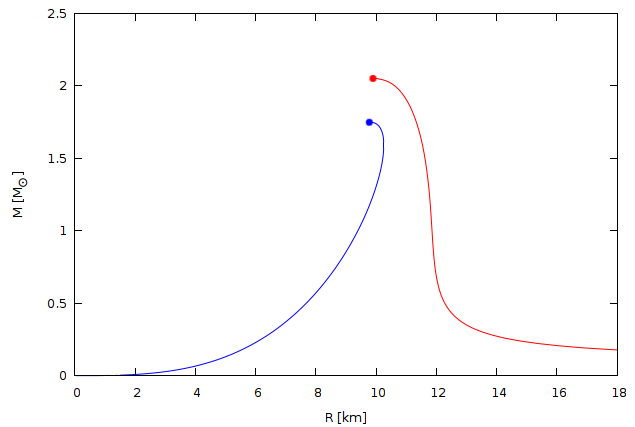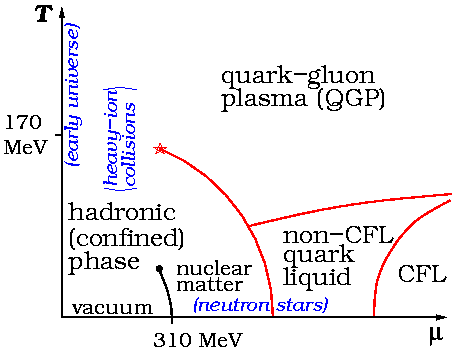|
SU(2) Color Superconductivity
Several hundred metals, compounds, alloys and ceramics possess the property of superconductivity at low temperatures. The SU(2) color quark matter adjoins the list of superconducting systems. Although it is a mathematical abstraction, its properties are believed to be closely related to the SU(3) color quark matter, which exists in nature when ordinary matter is compressed at supranuclear densities above ~ 0.5 1039 nucleon/cm3. Superconductors in Lab Superconducting materials are characterized by the loss of resistance and two parameters: a critical temperature Tc and a critical magnetic field which brings the superconductor to its normal state. In 1911, H. Kamerlingh Onnes discovered the superconductivity of mercury at a temperature below 4 K. Later, other substances with superconductivity at temperatures up to 30 K were found. Superconductors prevent the penetration of the external magnetic field into the sample when the magnetic field strength is less than the critical v ... [...More Info...] [...Related Items...] OR: [Wikipedia] [Google] [Baidu] |
Superconductivity
Superconductivity is a set of physical properties observed in certain materials where electrical resistance vanishes and magnetic flux fields are expelled from the material. Any material exhibiting these properties is a superconductor. Unlike an ordinary metallic conductor, whose resistance decreases gradually as its temperature is lowered even down to near absolute zero, a superconductor has a characteristic critical temperature below which the resistance drops abruptly to zero. An electric current through a loop of superconducting wire can persist indefinitely with no power source. The superconductivity phenomenon was discovered in 1911 by Dutch physicist Heike Kamerlingh Onnes. Like ferromagnetism and atomic spectral lines, superconductivity is a phenomenon which can only be explained by quantum mechanics. It is characterized by the Meissner effect, the complete ejection of magnetic field lines from the interior of the superconductor during its transitions into the sup ... [...More Info...] [...Related Items...] OR: [Wikipedia] [Google] [Baidu] |
Color Confinement
In quantum chromodynamics (QCD), color confinement, often simply called confinement, is the phenomenon that color-charged particles (such as quarks and gluons) cannot be isolated, and therefore cannot be directly observed in normal conditions below the Hagedorn temperature of approximately 2 terakelvin (corresponding to energies of approximately 130–140 MeV per particle). Quarks and gluons must clump together to form hadrons. The two main types of hadron are the mesons (one quark, one antiquark) and the baryons (three quarks). In addition, colorless glueballs formed only of gluons are also consistent with confinement, though difficult to identify experimentally. Quarks and gluons cannot be separated from their parent hadron without producing new hadrons. Origin There is not yet an analytic proof of color confinement in any non-abelian gauge theory. The phenomenon can be understood qualitatively by noting that the force-carrying gluons of QCD have color charge, unlike the p ... [...More Info...] [...Related Items...] OR: [Wikipedia] [Google] [Baidu] |
Quark Matter
Quark matter or QCD matter (quantum chromodynamics, quantum chromodynamic) refers to any of a number of hypothetical phase (matter), phases of matter whose degrees of freedom (physics and chemistry), degrees of freedom include quarks and gluons, of which the prominent example is Quark–gluon plasma, quark-gluon plasma. Several series of conferences in 2019, 2020, and 2021 were devoted to this topic. Quarks are liberated into quark matter at extremely high temperatures and/or densities, and some of them are still only theoretical as they require conditions so extreme that they cannot be produced in any laboratory, especially not at equilibrium conditions. Under these extreme conditions, the familiar structure of matter, where the basic constituents are atomic nucleus, nuclei (consisting of nucleons which are bound states of quarks) and electrons, is disrupted. In quark matter it is more appropriate to treat the quarks themselves as the basic degrees of freedom. In the standard mode ... [...More Info...] [...Related Items...] OR: [Wikipedia] [Google] [Baidu] |
Quantum Chromodynamics
In theoretical physics, quantum chromodynamics (QCD) is the theory of the strong interaction between quarks mediated by gluons. Quarks are fundamental particles that make up composite hadrons such as the proton, neutron and pion. QCD is a type of quantum field theory called a non-abelian gauge theory, with symmetry group SU(3). The QCD analog of electric charge is a property called ''color''. Gluons are the force carriers of the theory, just as photons are for the electromagnetic force in quantum electrodynamics. The theory is an important part of the Standard Model of particle physics. A large body of experimental evidence for QCD has been gathered over the years. QCD exhibits three salient properties: * Color confinement. Due to the force between two color charges remaining constant as they are separated, the energy grows until a quark–antiquark pair is spontaneously produced, turning the initial hadron into a pair of hadrons instead of isolating a color charge. Although ... [...More Info...] [...Related Items...] OR: [Wikipedia] [Google] [Baidu] |
Phases Of Matter
In the physical sciences, a phase is a region of space (a thermodynamic system), throughout which all physical properties of a material are essentially uniform. Examples of physical properties include density, index of refraction, magnetization and chemical composition. A simple description is that a phase is a region of material that is chemically uniform, physically distinct, and (often) mechanically separable. In a system consisting of ice and water in a glass jar, the ice cubes are one phase, the water is a second phase, and the humid air is a third phase over the ice and water. The glass of the jar is another separate phase. (See ) The term ''phase'' is sometimes used as a synonym for state of matter, but there can be several immiscible phases of the same state of matter. Also, the term ''phase'' is sometimes used to refer to a set of equilibrium states demarcated in terms of state variables such as pressure and temperature by a phase boundary on a phase diagram. Becau ... [...More Info...] [...Related Items...] OR: [Wikipedia] [Google] [Baidu] |
Quark Star
A quark star is a hypothetical type of compact, exotic star, where extremely high core temperature and pressure has forced nuclear particles to form quark matter, a continuous state of matter consisting of free quarks. Background Some massive stars collapse to form neutron stars at the end of their life cycle, as has been both observed and explained theoretically. Under the extreme temperatures and pressures inside neutron stars, the neutrons are normally kept apart by a degeneracy pressure, stabilizing the star and hindering further gravitational collapse. However, it is hypothesized that under even more extreme temperature and pressure, the degeneracy pressure of the neutrons is overcome, and the neutrons are forced to merge and dissolve into their constituent quarks, creating an ultra-dense phase of quark matter based on densely packed quarks. In this state, a new equilibrium is supposed to emerge, as a new degeneracy pressure between the quarks, as well as repulsive electrom ... [...More Info...] [...Related Items...] OR: [Wikipedia] [Google] [Baidu] |
QCD Matter
Quark matter or QCD matter (quantum chromodynamic) refers to any of a number of hypothetical phases of matter whose degrees of freedom include quarks and gluons, of which the prominent example is quark-gluon plasma. Several series of conferences in 2019, 2020, and 2021 were devoted to this topic. Quarks are liberated into quark matter at extremely high temperatures and/or densities, and some of them are still only theoretical as they require conditions so extreme that they cannot be produced in any laboratory, especially not at equilibrium conditions. Under these extreme conditions, the familiar structure of matter, where the basic constituents are nuclei (consisting of nucleons which are bound states of quarks) and electrons, is disrupted. In quark matter it is more appropriate to treat the quarks themselves as the basic degrees of freedom. In the standard model of particle physics, the strong force is described by the theory of QCD. At ordinary temperatures or densities ... [...More Info...] [...Related Items...] OR: [Wikipedia] [Google] [Baidu] |
Sign Problem
In applied mathematics, the numerical sign problem is the problem of numerically evaluating the integral of a highly oscillatory function of a large number of variables. Numerical methods fail because of the near-cancellation of the positive and negative contributions to the integral. Each has to be integrated to very high precision in order for their difference to be obtained with useful accuracy. The sign problem is one of the major unsolved problems in the physics of many-particle systems. It often arises in calculations of the properties of a quantum mechanical system with large number of strongly interacting fermions, or in field theories involving a non-zero density of strongly interacting fermions. Overview In physics the sign problem is typically (but not exclusively) encountered in calculations of the properties of a quantum mechanical system with large number of strongly interacting fermions, or in field theories involving a non-zero density of strongly interacting ferm ... [...More Info...] [...Related Items...] OR: [Wikipedia] [Google] [Baidu] |
Quantum Chromodynamics
In theoretical physics, quantum chromodynamics (QCD) is the theory of the strong interaction between quarks mediated by gluons. Quarks are fundamental particles that make up composite hadrons such as the proton, neutron and pion. QCD is a type of quantum field theory called a non-abelian gauge theory, with symmetry group SU(3). The QCD analog of electric charge is a property called ''color''. Gluons are the force carriers of the theory, just as photons are for the electromagnetic force in quantum electrodynamics. The theory is an important part of the Standard Model of particle physics. A large body of experimental evidence for QCD has been gathered over the years. QCD exhibits three salient properties: * Color confinement. Due to the force between two color charges remaining constant as they are separated, the energy grows until a quark–antiquark pair is spontaneously produced, turning the initial hadron into a pair of hadrons instead of isolating a color charge. Although ... [...More Info...] [...Related Items...] OR: [Wikipedia] [Google] [Baidu] |
Lattice QCD
Lattice QCD is a well-established non-perturbative approach to solving the quantum chromodynamics (QCD) theory of quarks and gluons. It is a lattice gauge theory formulated on a grid or lattice of points in space and time. When the size of the lattice is taken infinitely large and its sites infinitesimally close to each other, the continuum QCD is recovered. Analytic or perturbative solutions in low-energy QCD are hard or impossible to obtain due to the highly nonlinear nature of the strong force and the large coupling constant at low energies. This formulation of QCD in discrete rather than continuous spacetime naturally introduces a momentum cut-off at the order 1/''a'', where ''a'' is the lattice spacing, which regularizes the theory. As a result, lattice QCD is mathematically well-defined. Most importantly, lattice QCD provides a framework for investigation of non-perturbative phenomena such as confinement and quark–gluon plasma formation, which are intractable by means ... [...More Info...] [...Related Items...] OR: [Wikipedia] [Google] [Baidu] |
Nambu–Jona-Lasinio Model
In quantum field theory, the Nambu–Jona-Lasinio model (or more precisely: ''the Nambu and Jona-Lasinio model'') is a complicated effective theory of nucleons and mesons constructed from interacting Dirac fermions with chiral symmetry, paralleling the construction of Cooper pairs from electrons in the BCS theory of superconductivity. The "complicatedness" of the theory has become more natural as it is now seen as a low-energy approximation of the still more basic theory of quantum chromodynamics, which does not work perturbatively at low energies. Overview The model is much inspired by the different field of solid state theory, particularly from the BCS breakthrough of 1957. The first inventor of the Nambu–Jona-Lasinio model, Yoichiro Nambu, also contributed essentially to the theory of superconductivity, i.e., by the "Nambu formalism". The second inventor was Giovanni Jona-Lasinio. The common paper of the authors that introduced the model appeared in 1961. A subsequent ... [...More Info...] [...Related Items...] OR: [Wikipedia] [Google] [Baidu] |




